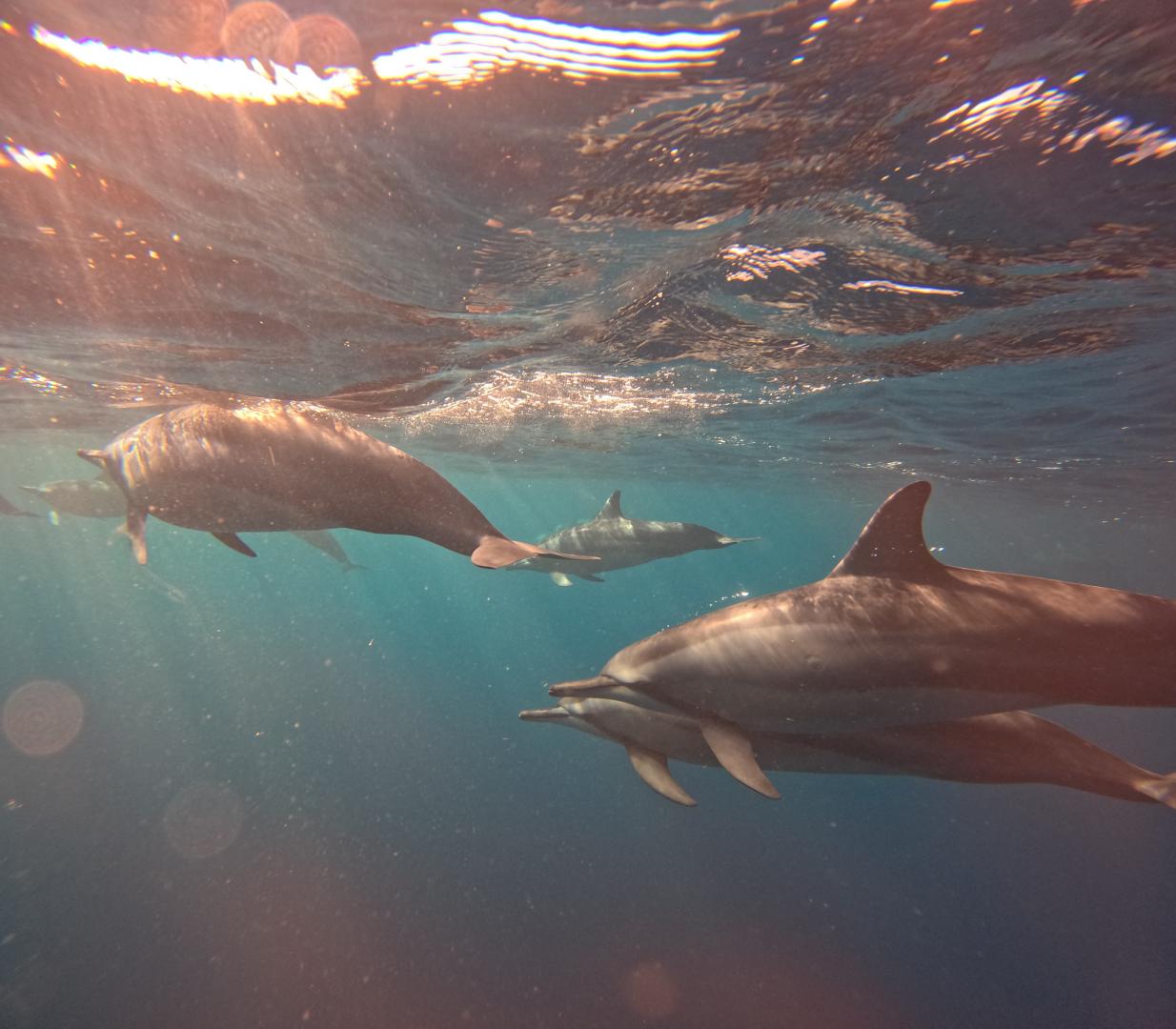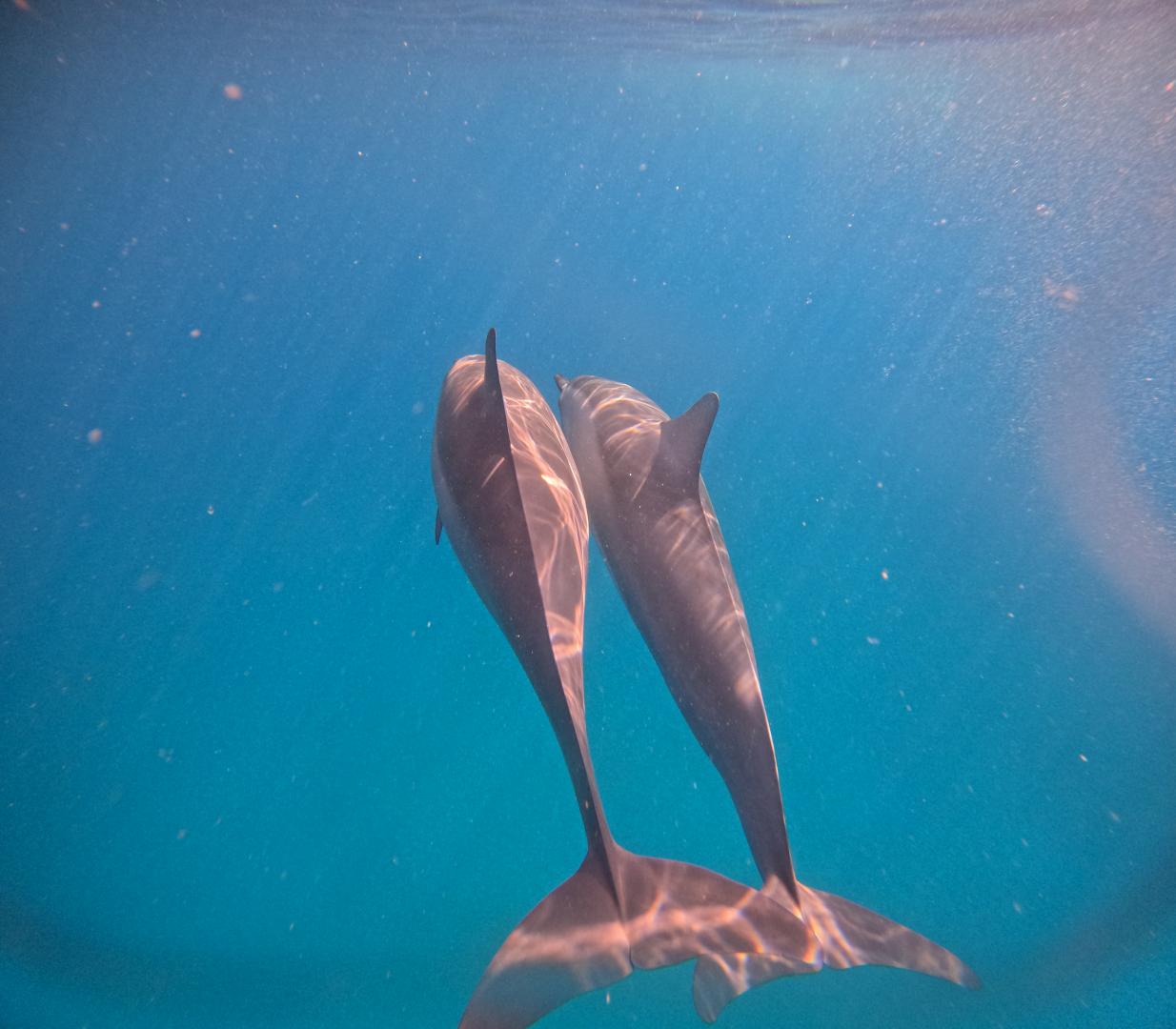Dolphins and Whales Combined - Mauritius
Combined whale watching and swim with dolphins excursion
Duration: Approximately 4 hours | Departure: 6:00 AM
The excursion therefore combines the two previous excursions, whale watching and the encounter with dolphins. This is our must-have bestseller!
Whale Watching
Sperm whales can be seen year-round off the coast of Mauritius. Humpback whales migrate here from June to October to breed.
We locate humpback whales by following their blow and use hydrophones to find sperm whales.
Respect for the animals is essential: we avoid disturbing them and stay nearby for about an hour.
Dolphin Watching & Swimming
We search for dolphins, often near the shore. If conditions are favorable, you’ll have the chance to swim with them while following strict guidelines to protect their wellbeing.
The order of encounters (dolphins or whales first) depends on the conditions and animal locations.
Return time may vary depending on their position.
Optional Reef Snorkeling
A snorkeling session can be added to explore the colorful coral reef and marine life.
On Board
Sweet and salted snacks, along with tea, coffee, and non-alcoholic beverages, are provided.
Snorkeling equipment (fins, masks, snorkels) is available, or you may bring your own.
We have a 90% chance of finding whales !
Dolphin swimming and whale watching :
- Private trip - Golden Wave II boat - Rs 26,000 / € 550
- Private trip - Golden Wave V boat - Rs 30,000 / € 640
- Private trip - Golden Wave III boat - Rs 42,000 / € 900
- Sharing trip - Rs 6,500 / € 140 per person
GoPro (Photos and Videos with dolphins), Sea Scooter and Snorkeling on the reef options available.
Click on the button below to access our price list :


Option for Underwater Photos and Videos with Dolphins
Experience a unique adventure in Mauritius: swim with dolphins and capture these magical moments in photos and videos.
Our team, equipped with the latest GOPRO, will guide you while respecting the dolphins. We will send you the videos and photos via Dropbox or WeTransfer.
You also have the option to add an extra stop for snorkeling on the reef.
Enjoy this exceptional and environmentally friendly experience!
Price :
Golden wave II boat - Rs 4,000 / € 85
Golden Wave V boat - Rs 5,000 / € 110
Golden wave III boat - Rs 6,000 / € 130
Species information
Mauritius is home to many resident Sperm Whale pods.
The most common Whale in Mauritius are found in the deep sea, where they dive to feed.
Females and young males live together in family groups, the mature males migrate alone.
The mature male's average size is 15 meters, but some big specimens can be 20 meters long and weigh 50 tons!
This is the biggest toothed cetacean and the largest predator on the planet.
Sperm whales can dive up to 2000 metres and stay up to 2 hours underwater. These amazing mammals go to this depth to find their preferred food, the giant squid, who can weigh up to 500 kg .
Males migrate to Mauritius to breed with the resident females.
Unfortunately, hunted during many years for their oil, sperm whales are now protected by the international whaling commission.
Humpback whales migrate to Mauritius to mate and have their young.
Humpbacks are a baleen species, mature males can be 15 metres long and weigh 50 tons. They can live up to 60 years and are known for their unique song, particulary the males during the breeding season.
Most of the time we find them close to the shore, where the females find shelter with their babies. Males are often and counted further offshore.
These amazing whales can travel up to 25000 km per year, when they migrate between polar seas to feed and Mauritius to breed.
Humpback whales don't have teeth, they have baleen which they use to filter feed on small fish and crustaceans from the sea.
They are encountered in Mauritius only during winter time, from May until September.
Commecially hunted for many years, before the moratorium of 1966, the global Humpback population fell by an estimated 90%.
Today, scientists estimate the rebounding population of Humpback whales is about 80 000.
Pilot whale families are year round residents in Mauritius.
The second largest of the Dolphin species, in Mauritius we encounter the short finned Pilot whale.
We find them in large groups mainly in the deep sea like the sperm whales. Family groups are led by the oldest female in the pod.
Pilot whales mostly eat deep sea squid, diving up to 700 meters for 12 - 16 minutes per dive.
Males can live up to 45 years and the females up to 60.
Pilot whales in Mauritius can grow up to 5,5 m long for the female and 7,5 m long for the male which can weigh up to 3300 kg.
Unfortunately, Pilot whales are still hunted in some parts of the World. But like all cetaceans, Pilot whales are protected in Mauritius.
In Mauritius, we frequently see two distinct species of dolphins:
The Spinner Dolphin:
- This tripartite species has a white belly, light gray flanks, and a dark gray back. Its large bill makes it easy to identify.
- Adults typically weigh between 55lbs and 176lbs and range in size from 1,3 to 2,3 meters.
- Their lifespan is 25 years.
- There are the acrobats of the ocean. During a jump, they can spin eight times!
The Bottlenose Dolphin:
- So named because of its small, thick beak. He usually has a light gray color.
- The adult weighs between 330lbs and 1433lbs and measures between 2,3 and 3,8 meters.
- It has a life expectancy of 50 years.
- They have a ten-fold increase in hearing capacity over humans!
- Dolphins move in groups known as "schools" and can swim 45 km/h.
During the day, they reside near the coast and reefs, and at night, they move farther offshore.
To enjoy these magical moments in the company of dolphins, you will have to get up early! Indeed, we try to be the first on the ocean, so we can watch and swim with them with RESPECT.
